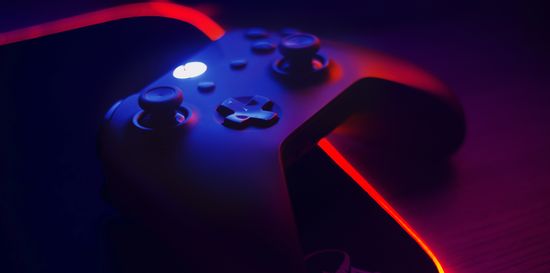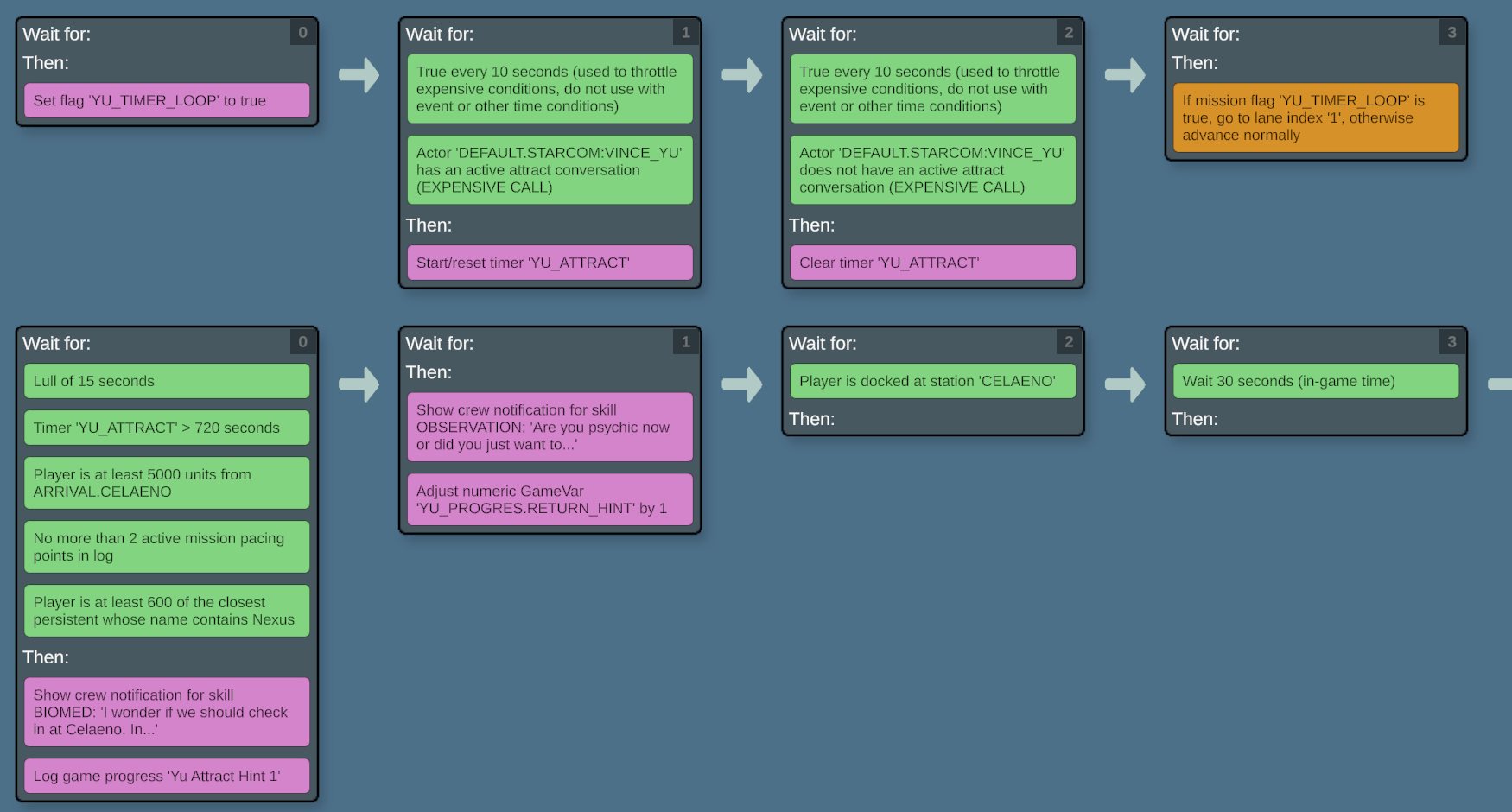- [p]First, it hopefully addresses a long standing bug that caused skill check modifiers after certain anomalies not to be reset, leading to weird modifiers, like +1530%.[/p]
- [p]Two, it implements necessary changes for future Workshop story content. That is, once the Creator Tool is ready, Creators will be able to share their content with other players via the Workshop. [/p]

Starcom: Unknown Space
Weekly Update: June 27, 2025
Weekly Update: June 20, 2025
Starcom: Unknown Space is Steam Deck Verified!
Weekly Update: June 6, 2025
Nordic Game
[p][/p][p]In the first half of the trip we were in Malmö, Sweden for the Nordic Games conference. This was the first time I've gone to a game developer conference and didn't have a concrete agenda: my main reasons for selecting this one specifically were: a) it happened to fall at a time where I felt like I could take a break, b) Copenhagen (a 20 minute train ride from Malmö) is a direct flight from Boston, and c) I've never been to Scandinavia.[/p][p][/p][p][img src="https://clan.akamai.steamstatic.com/images/42185452/b4e0692599c1f9feee10a98a1424323f9b1fb622.png"][/p][p]I had a lot of fun, talked to a number of interesting developers, and saw a bunch of cool talks on different aspects of game development.[/p][p][/p][p]The two most interesting talks I saw were one by Fawzi Mesmar (designer at Ubisoft) and one by Marie Mejerwall (systems designer) on AI.[/p][p][/p][p]Mesmar's talk was on creativity, and I liked that he had a pretty clear thesis on what creativity was: a statistically unlikely idea that creates value in some context. [/p][p][/p][p][dynamiclink href="https://youtu.be/7i6wuit8dXE?t=361"][TAG-30][/p][p]I appreciated that he's attempted to put out a fairly robust definition for something that is usually described in a very handwavy manner. [/p][p][/p][p]Mejerwall's was more technical on combat AI as Finite State Machines. This one was interesting to me because I've been thinking about how I might rework NPC AI's to be more modular. She didn't talk specifically about modularity, but a few of the things she did say sparked some ideas for me:[/p][p][/p][p][dynamiclink href="https://youtu.be/N2cVhqpz71c?t=170"][/p][p][/p]The Faroe Islands
[p][/p][p]The second half of the trip was spent in the Faroe Islands, which provided a nice slower-paced cooldown from the intense social activity of the conference. Kristin has wanted to go to the Faroes for quite some time, and I thought they would be a great place to find some anomaly inspirations. I've talked before about the process of generating anomaly images, where I mostly have relied on kitbashing assets in 3D environment rendering software. I have several techniques that I've learned over time to produce images that are both visually appealing and spark some sense of alien mystery.[/p][p][/p][p]I took a lot of reference pictures while we were there: not so much to specifically recreate a location, but to have something to understand when/how a 2D image can communicate things like distance and scale. Most everyone has had the experience of taking a photo of something dramatic only to discover that the image is somehow much less impressive than what you saw. Reversing this process is a big part of anomaly visuals: taking basic models/shaders and using tricks of perspective, scale and lighting to make them look convincingly alien and impressive. So finding locations that look impressive in real life and then also translate well as images can help me figure out what types of terrain layouts will work well.[/p][p][/p][p]One of the most famous locations in the Faroe Islands is Traelanipa, a dramatic cliff where a lake seems implausibly posed above sea caves. [/p][p][/p][p][img src="https://clan.akamai.steamstatic.com/images/42185452/28173e4dadef2a0aac54d19615c221fdef70fb3e.png"][/p][p]This is partly an optical illusion: While the lake is 100' above sea level, the cliff's edge is 250' above sea level, but slopes down quickly below the eyeline. The large scale, plus lack of reference objects of known size like trees or buildings tricks the eye into thinking the lake must be about to spill over the cliff's edge. [/p][p][/p][p](The general lack of trees and large vegetation has some additional advantage for my purposes: for one, these environments naturally look more "alien". For another, lots of independent meshes are really computationally expensive to place and render. Terrain that looks good with just a shader applied is just overall an easier environment to create.)[/p][p][/p]What's Next?
[p][/p][p]A number of people have asked about my future plans now that Starcom: Unknown Space has reached the point where I am mostly just making minor bug fixes and QoL updates. (There was a minor patch this week as the games inches hopefully closer to Steam Deck "verified" status.)[/p][p][/p][p]One can infer from my activities on this trip that I am at least considering making another entry into the Starcom universe. I haven't 100% decided that's what I am going to do: building these games has been both enormously rewarding but also challenging and stressful. Right now, my current plan is to allow myself to relax a bit, but start thinking about what another Starcom game would look like if I were to make one.[/p][p][/p][p]I plan to put a survey up in the next week or two.[/p][p][/p][p]Until then, thanks for reading my "What I Did on Spring Break" report![/p][p][/p][p]- Kevin[/p][p][/p] Minor Deck Patch
Weekly Update: May 16, 2025
This is actually the first time I've ever attended a game developer conference: when I first started out doing indie game development, it was not at all clear that this would be a profitable endeavor, so I resisted any expense that wasn't absolutely essential for making the game I was working on.
At a certain point the Starcom games became successful enough that a conference would be a reasonable expense, but I was so overwhelmed with the literal thousands of tasks that I rarely felt like I could spare the time, and when I could it didn't necessarily align with an industry event I was interested in.
Now that Starcom: Unknown Space has been out of Early Access for 8 months, I'm still making updates, but they aren't critical patches: mostly QoL improvements, bug fixes and addressing the few remaining areas where players need a bit more guidance.
This felt like the ideal time to take a workcation and see what other developers are doing, and the Nordic conference fit our schedule.
So the regular weekly updates may pause or be irregular for the next two weeks until I get back, although I will be checking emails and the forums periodically.
Until then!
- Kevin
Weekly Update: May 8, 2025
On Sunday I posted build 21533 which addressed a few QoL type issues and aimed to fix several of the remaining "stuck" issues. These are spots where the main storyline appears to stall out. Most of these cases arise from the player doing something different from how I expected and therefore missing or not triggering the next directive.
One scenario that I've seen multiple reports for at this point is where a storyline is waiting for the player to return to Celaeno, at which point Cdre Yu will give an update and/or new assignment. So one of the new changes is to have a crew member suggest returning to Celaeno if Yu has an active "attract" conversation (i.e., a conversation that causes the Operations button to glow) for an extended period of time.
This was a bit tricky for technical reasons. When I designed the conversation system, I was not overly concerned with the performance cost of initializing and evaluating a dialogue tree: it was something that happened only at the start of a conversation, so spending 1 ms on the operation wasn't exorbitant. As I later discovered, the evaluation can leak a small amount of memory under some circumstances. But as long as this evaluation is rare, it's not a big deal.
But if I want to check if Yu has an attract conversation, I have to do this evaluation regularly.
As I've previously discussed, the mission system evaluates missions every 0.16 seconds. Even though that's somewhat infrequent, I think that's still too frequent to perform a check that costs 1ms in order to resolve a scenario that most players may not be encountering.
Fortunately, the mission system uses "short-circuit" evaluation so that if one condition fails, no later condition in the same check even happens.
So here's my solution:

By way of analogy, imagine the first lane is someone with a stopwatch who starts it when Yu's conversation button starts glowing, and resets the stopwatch when they notice it's not glowing anymore. Also, they're kind of distracted so only check every ten seconds.
The second lane is someone looking at that stopwatch. As soon as it hits twelve minutes they tell the Biomed officer to say something. A second prompt can occur after that point if the player returns to Celaeno.
Based on the game's anonymous analytics, I know that players have been triggering these prompts. But due to limitations of my analytics, I don't have a super clear picture of where they are in the game when they happen. So rather than spend a lot of time trying to add instrumentation, I'll just ask here:
If you've gotten a prompt in game to return to Celaeno, where in the game were you, what was it that Yu was waiting to tell you and did the timing seem reasonable?
FYI, I won't be responding to discussion posts or feedback for the next few days. Until next week!
- Kevin
Kepler 21533 Update
- Visited trade planets are considered "explored" for purposes of dimming explored stars (existing saves may need to revisit system)
- "Highlight investigate" will also cause unexplored star systems to pulse
- Add First Officer tip about star dimming
- If Cdre Yu has a new "glowing" conversation topic for an extended period of time, eventually a crew member will suggest returning to Celaeno
- The Heretic Portal "Kaleidoscope" hint no longer advances when the player revisits the portal, instead it waits for the player to activate it
- Add hint lane to Southern Chariot if player hightails away from Chariot before it jumps
- A random void system with an ocean planet is added mid-game to ensure Floral Blight can always be completed
Weekly Update: May 2, 2025
On Monday I posted a small patch that adds the ability to load a blueprint even if you don't have the requirements while in planning mode (plus a few minor other fixes).
I've also started work on another minor update that will attempt to address some of the remaining cases where the main storyline has appeared "stuck" for some players.
Until next week!
- Kevin
Kepler Patch 21531
- If the player is in Planning Mode in the shipyard they will be able to load blueprints that they do not have the tech/resources for
- "Exit station" and "Delete saves" alert/confirmation dialogues now allow selection of a button when using the controller
- Several more minor typos
